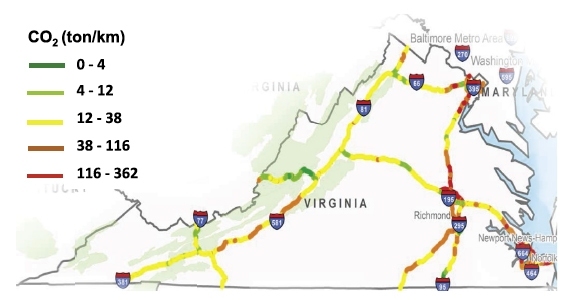The roadway network is an important part of the nation’s transportation system, but it also contributes heavily to greenhouse gas emissions. A paper published this month in the Journal of Cleaner Production by researchers with the MIT Concrete Sustainability Hub (CSHub) introduces a way to reduce emissions across a roadway network by using big data to identify specific pavement sections where improvements will have the greatest impact.
For the recent paper, CSHub researchers Arghavan Louhghalam and Mehdi Akbarian, and Professor Franz-Josef Ulm, the CSHub faculty director, studied over 5,000 lane-miles of Virginia’s interstate highway system.
“We found that the maintenance of just a few lane miles allows for significant performance improvement, along with lowered environmental impact, across the entire network,” explains Louhghalam, the paper’s lead author. “Maintaining just 1.5 percent of the roadway network would lead to a reduction of 10 percent in greenhouse gas emissions statewide.”
Use-phase impact has historically been ignored in the life cycle assessment of pavements, due in part to the difficulty of obtaining real-time data and a lack of effective quantitative tools. CSHub models recreate the interaction between the wheel and pavement and allow researchers to directly observe the interplay with varying road conditions, pavement properties, traffic loads, and climatic conditions.
The method presented in this paper integrates those pavement vehicle interaction (PVI) models into several databases used by transportation agencies. A ranking algorithm allows local results to be scaled up and applied to state or national sustainability goals, providing the shortest path to greenhouse gas emissions savings through maintenance at the network scale.
“The quantitative approach is less subjective than qualitative methods, and it’s easy to use,” Louhghalam says. “Decision makers can take more factors into account and make smart choices that are economically and also environmentally optimal.”
This study quantified the impact of deflection-induced PVI (which refers to the stiffness of the pavement) and roughness-induced PVI (which refers to the unevenness of a road’s surface) on the excess fuel consumption of vehicles. Results showed deflection-induced PVI is a major contributor to excess fuel consumption for trucks, due to their higher weights, and roughness-induced PVI impacts are larger for passenger vehicles, mainly due to higher traffic volume.
The researchers compared their approach to other methods, such as random maintenance, choosing roads based on traffic volume, and the current common practice of selecting roads based on their International Roughness Index values. The data-driven method allows for a maximum reduction in CO2 emissions with minimum lane-mile road maintenance.
“There is huge potential to improve efficiency and lower environmental impact through better design and maintenance of roadways,” says Ulm. “This work supports one of our major goals, which is to aid decision makers, including engineers and politicians, in thinking about infrastructure as part of the solution in a carbon-constrained environment.”
The MIT Concrete Sustainability Hub is supported by the Portland Cement Association and the Ready Mixed Concrete Research and Education Foundation.







